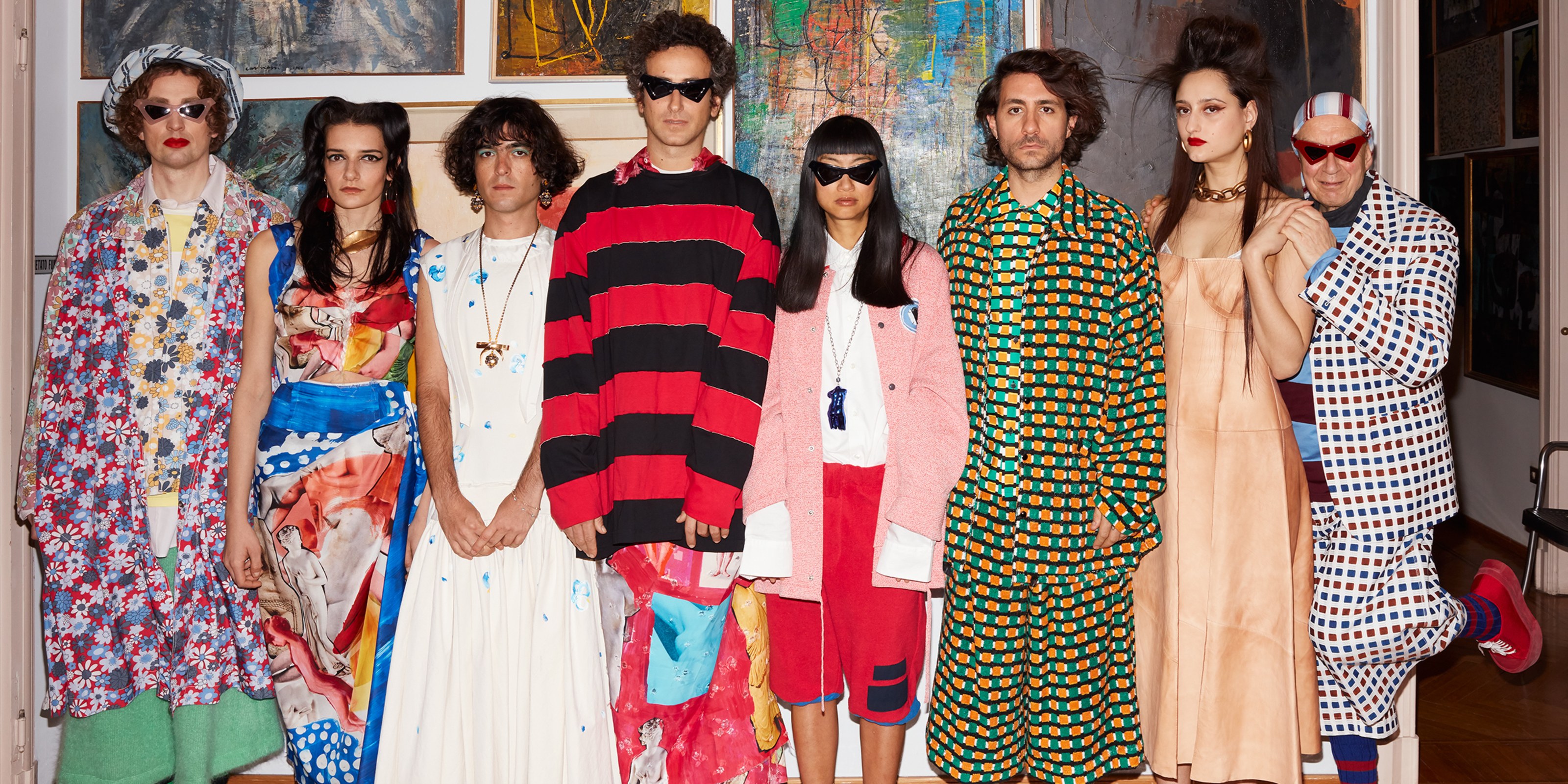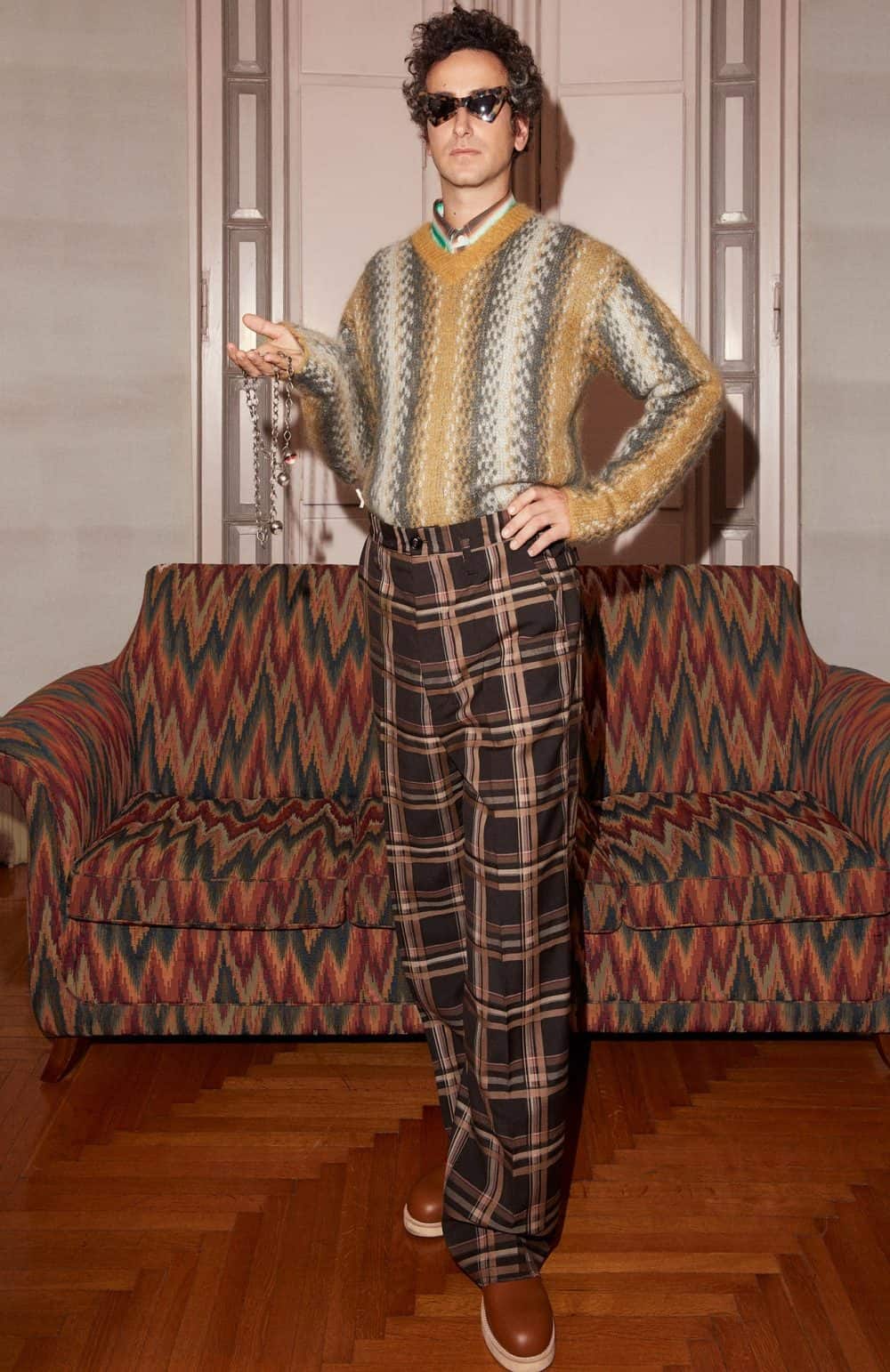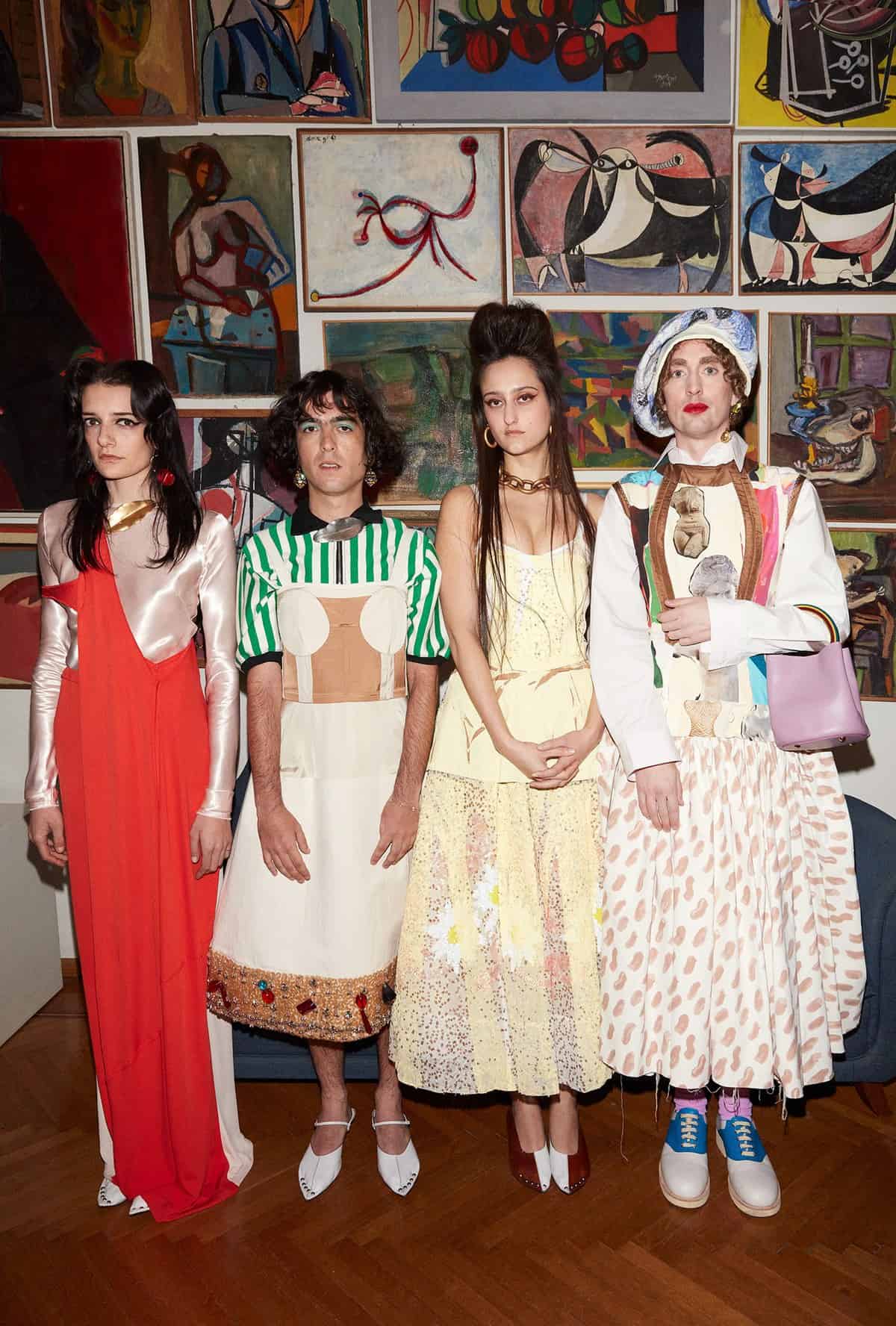The Exuberant World of Francesco Risso, Marni’s Design Darling
by Joshua Levine
Photographed by Walter Pfeiffer
Styled by Sara Moonves
Executive Production Lupetta5&BelowTheLine
Everybody parks where they shouldn’t in the center of Milan—it’s hard to park any other way. Still, to get away with it, it’s probably not a good idea to drive around in a hulking, gleaming white 1969 Citroën DS. Such concerns don’t stop Francesco Risso, the 36-year-old creative director of Marni. “There,” he says brightly, as he coaxes his classy but balky machine into a forbidden spot on the Via Manzoni, right outside of an antique-jewelry shop called Gioielleria Pennisi. “A bit illegal as always.”
Risso comes here a lot to buy presents. Today, he’s shopping for his partner, the American designer Lawrence Steele, who collaborates closely with him at Marni. The boutique’s owner brings out an unusual ring from the 1940s, with two heads carved from the red-brown gemstone tigereye. Risso tends to know his own mind and pulls the trigger quickly. Sold. Then, because the jeweler can tell what Risso likes, he follows up with an unexpected stunner: a little Chinese man made of gold, the sleeves and hem of his robe encrusted with diamonds, carrying a pole across his shoulders from which hang four gemstone lanterns. It’s an English brooch also from the 1940s. Risso is clearly enchanted, but wavers a bit here. “Fantastico! But it looks very expensive. I don’t know who I could give it to, or even if I could wear it myself.” It does indeed cost a small fortune, but despite the show of resistance, five minutes later it’s being wrapped up.
“I’m a passionate collector of images,” Risso tells me moments later over a bloody steak at Torre di Pisa, a favorite restaurant of Milan’s fashion crowd. “I like to imagine characters in a story, but you need a reference—a flower, a piece of art, anything that can connect you with that story. Today, I found this incredible Chinese man holding lanterns. I hope one day, opening my drawers, to bring out a story that will be an inspiration for something.”
In the case of Marni’s current women’s-wear collection, the story started with an exhibition at the Tate museum, in London, that Risso caught last year. Titled “All Too Human,” it featured nude portraits from British painters like Lucian Freud, and Jenny Saville. “I was thinking about that show all season—the intimacy of these friends of the artists posing and being completely, ‘Whatever—just paint me however you want.’ It’s not about the pose; it’s the skill of the painter making the skin visceral and vivid and human.”
The path from naked human form to high-fashion frock is not a linear one. In Risso’s case, it emerges in the collection’s solarized leather dresses that cling to the body “like a second skin.” It shows up, too, in the way he cut his fabrics, even when they are plastered haphazardly with images of classical statues or wild splashes of paint. Risso says he wanted the bodies underneath his clothes to broadcast their own rude fleshiness, the way Freud’s impudent nudes do. “The casting for the show took a lot of research. It was about bodies—proud bodies, even when they were skinny or more round.”
The general feeling is that Risso is successfully putting his own stamp on Marni, which he joined just three years ago, at the young age of 33. It’s an identity that comes through instantly when you meet him. He’s tall and slim, with a head full of curls and an unguarded face that makes him look 10 years younger than he is. When he emerges from his white Citroën the morning we meet, he is wearing a black baseball cap, a long brown leather coat, a white sweater with long ragged sleeves emerging from underneath a striped T-shirt, and wide-flared bell-bottoms. The effect is boyish and a little girly too, but he’s not making a fuss about it. “What can I say? Most of my friends are fluid. I don’t need to declare it,” he says. In Marni’s men’s-wear show this past January, Risso cast several women as models. If no one told you, you probably wouldn’t have even noticed.
“When I met him 12 years ago, his persona was already very much defined,” Lawrence Steele says. “He looked like a little clochard boy, a poet.” Soon after they were introduced by mutual friends, Steele invited Risso to join him and a friend at a concert. Risso didn’t know it was Steele’s birthday until after midnight, but when he found out, he ran off and reappeared bearing an ice cream sandwich with a fat candle stuck in it. Steele was granted one wish, and it came true. The couple got engaged on Steele’s birthday last year.
Risso’s frisky aesthetic extends to the settings he concocts for his runway shows—say, an underground parking garage lined with big green and black rubber exercise balls, or a room filled with beds for editors and buyers to recline on. He also designs for kids, and he designs jewelry. Occasionally, he dabbles in fun furniture too. For 2017’s Salone del Mobile, he conceived something he called Marni Playland. Using a vast warehouse floor, Risso created a giant sandbox and scattered multicolored plastic-woven chairs, baskets, and knickknacks around it.
This kind of thing is clearly not the work of a solitary brooder, and Risso’s merry band of playmates—it seems too stiff and old-fashioned to call them muses—are never far off. They are an integral part of Risso’s creative universe, and he has cast them as recurring characters in the theater of his imagination. The Croatian model and digital artist Nikolina Nina Granic, one of Risso’s close friends, has walked in his women’s-wear and men’s-wear shows. Granic got Risso thinking about the Venus de Milo, an image that showed up, after several twists and turns, in his latest collection. Last year, Risso met the model Jess Maybury, whom he says reminds him of the Mona Lisa, and she quickly joined the crew. “They are my artists—it’s almost like I’m breathing through their characters,” Risso says.
Instagram is a good place to become acquainted with these characters. Risso’s buddy Matheus Lomonte wears a blue dress, red knee socks, and yellow heels on his feed @moonriverchacha. Risso met Gösta Andreas Lönn Grill (@andreasgrill) through social media, where they bonded over a shared obsession with aliens and UFOs. Risso’s account, @asliceofbambi, features images of aliens, old movie stills, fingernails carved like teeth, and a dog trying to bite a rainbow. Risso’s digital identity might seem a bit wacko, but it’s never haphazard. In fact, mindfulness is one of his favorite words, and he applies it painstakingly to everything he touches, including his unhemmed trousers and mismatched layers.
Still, the early going at Marni was tough. The problem wasn’t Risso’s worldview, but the willingness of Marni lovers everywhere to embrace it. Marni came straight from the mind of Consuelo Castiglioni, who founded the label in 1994 with her husband, Gianni, who also ran his family’s successful fur business. Castiglioni designed by instinct, and for 20 years did her own thing, which was always hard to pin down. Certain words kept popping up to describe it—architectural, flowery, crisp, textural. In the end, it came down to whatever turned her on, and her devotees adored her for it.
Renzo Rosso’s OTB Group bought Marni in 2012, and it was Rosso who gave Risso his shot four years later. “Definitely, what people saw when I started at Marni was that I didn’t necessarily respect the codes of the house, which might be true,” Risso says. “It was quite unsettling at the moment, but I don’t regret it. I am a big fan of Consuelo—otherwise, I wouldn’t be here—but I can’t be her clone. I have to be coherent with my own self.”
On the personal front, forging any kind of a coherent self at all took some doing. He had the kind of storybook childhood that could also be a curse—may you be raised by fascinating parents. He was born on the deck of a sailboat off Sardinia during the five years when his parents decided that life at sea might be fun. They all moved back to Genoa, where his parents had lived before, when Francesco was 4. His father, a lawyer by training, was in reality a professional Peter Pan. “He would wake up one morning and tell my mom, ‘Oh, I’m going to Brazil for a month to move all these horses from one country to another,’ and we would be like, ‘Okay, whatever.’ ” His mother had a spine of steel, but little time for Francesco; the primary beneficiary of her talent was Benetton, where she held a top job.
“It was totally crazy, and to be honest, it wasn’t easy,” Risso recalls. “I had very distracted parents, and I grew up quite without them.” The only way to survive, Risso determined, was to leave. And so, shortly before he turned 16, he set himself up in Florence and began taking classes at Polimoda, the prestigious fashion school. A year later, he was off to FIT, in New York, where he learned the mechanics of constructing a garment. What FIT didn’t nurture, says Risso, was the creative spirit. He got that at London’s Central Saint Martins, studying with the school’s much-loved eminence Louise Wilson, who passed away in 2014. “She was so strict in teaching you to explore inspirations that don’t necessarily come from fashion but from whatever you find in life,” Risso says. “To look at the most irrelevant thing in order to find the most relevant thing—that was precious.”
It was a helpful tool to have when Steele brought Risso to Fabio Zambernardi’s attention, in 2008. Risso was working for Alessandro Dell’Acqua in Milan at the time; Zambernardi was the design director for Prada—he still is—and Steele had worked there in the early 1990s. Miuccia Prada, Zambernardi’s boss, is famous for plucking ideas from the ether and teasing them into a collection through rigorous analysis. The process is not for the faint of heart. “The conversations are very abstract at the beginning. You need people who can take it to another level, and Francesco was very good at that,” says Zambernardi, who remains a close friend.
Risso spent eight happy years at Prada, and the heady push-pull of its creative process shaped him forcefully as a designer. “Francesco manages to put things together in a very personal way, playing with references that come from different places,” says Julie de Libran, the creative director at Sonia Rykiel, and another Prada alum. “What he’s doing at Marni feels more real than what the big brands are doing. We have too many clothes, and it’s wonderful to see a young designer giving value to things, making them less throwaway, adding a story to the workmanship.”
The white Citroën DS lurches back out into Milan’s downtown traffic. Risso’s dad collected old cars, too, and Risso hated it. “We would go to the mountains in an old MG, and we were like, ‘We’re fucking freezing inside here!’ I was so pissed. Now, I’m becoming like him. I have fights with Lawrence that look exactly like the ones my mom and dad would have, but now I get why my dad would be so passionate about certain things.”
Some years after he left home, Risso managed to set things right with both of his parents. He’s now very close to his mother, on whose shrewd counsel he often relies. His father, who had Parkinson’s disease and Alzheimer’s, died in 2009, but Risso was there for his final years. “Sometimes, I look at things I’ve created and I’m like, ‘Oh, my God, that’s so familiar,’ ” he says. “I always go back to the seriousness of a child at play. To me, it’s more about a quality of spontaneity rather than childishness.” That isn’t something you can practice, of course, but he does what he can by looking for ways to constantly stimulate his curiosity.
Before I leave him, Risso takes me to his favorite bookstore, in Milan’s imposing Galleria Vittorio Emanuele. He’s an avid book collector, with a huge library at home—but the problem is, it’s a total mess, he confesses. “Like, a few weeks ago, I was looking for a book of this Japanese photographer who took pictures in Brazil in the 1960s. It took me days!” There’s an easy solution to that, I offer. Just organize your library. Risso allows he could do that, of course, but it’s unlikely that he will. “There is something so nice,” he says, “about the surprise of finding something you didn’t expect while you’re looking for something else.”










